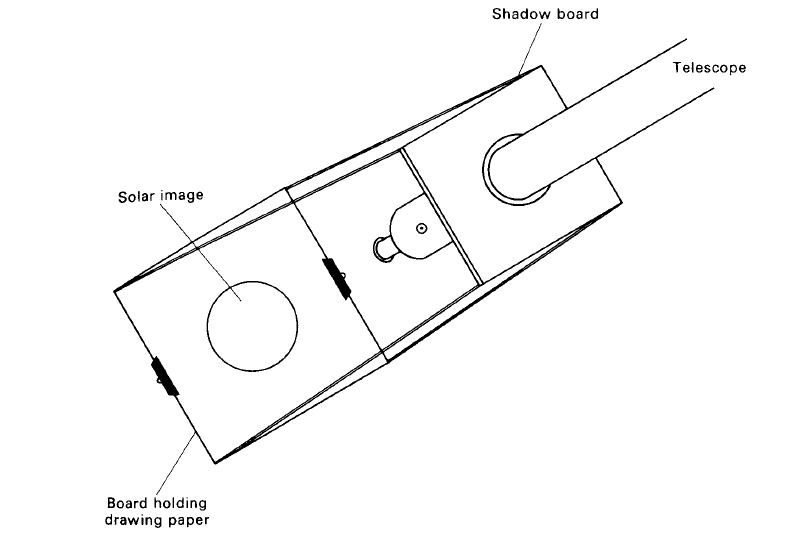
Solar disc phenomena: Recording sunspots by drawing
 المؤلف:
A. Roy, D. Clarke
المؤلف:
A. Roy, D. Clarke
 المصدر:
Astronomy - Principles and Practice 4th ed
المصدر:
Astronomy - Principles and Practice 4th ed
 الجزء والصفحة:
p 325
الجزء والصفحة:
p 325
 5-9-2020
5-9-2020
 2045
2045
Solar disc phenomena: Recording sunspots by drawing
A more convenient way of looking at the features on the solar disc is by the projection method. If smooth white paper is held at a distance behind the eyepiece of a telescope which is directed to the Sun, a large image may be focused on to the paper, this being very suitable for viewing by groups of people. The best eyepiece to use is one of low power, preferably a Huyghens type in which the component lenses are not cemented together. (Cemented lenses are prone to damage by the heat from the Sun.)
By making a frame which can be attached to the telescope so that the paper may be clipped to a board, it is then an easy matter to draw the positions and details of the solar markings. The contrast of the projected solar image may be improved by also fitting a shadow board around the telescope tube. A schematic projection frame is depicted in figure 1.
The projection technique also allows considerable detail to be seen and drawn. For example, it should be noticed that the solar disc is not uniformly bright and that it fades towards its edge (limb darkening). Sunspots and sunspot groups should be seen with structure—the spots showing a strong core (umbra) surrounded by a less black region (penumbra) which may show structure such as filaments radiating outwards. Small bright patches (faculae) may be evident particularly near to the spots or towards the edge of the Sun where the limb-darkening effect produces a background with lower illumination. The detection of faculae may be made easier by gently shaking the frame which holds the paper.
When drawing the solar markings by the projection method, it is important to provide axes to which specific points may be referred and the north–south, east–west lines may be generated for this purpose. As convention, the north, south, east and west limbs of the Sun are defined according to the

Figure 1. A simple projection board for drawing solar phenomena.
directions on the sky—to the unaided eye in the northern hemisphere, north is to the top and east the left.
Keeping the telescope fixed, allow the solar image to drift across the projection board and rotate the paper on the board until the upper edge of the Sun moves along or parallel to the upper edge of the paper. This edge of the paper now corresponds to the east–west direction on the sky. By noting the direction in which the image moves when the telescope is kept fixed, the image drifting because of the diurnal motion of the Sun across the sky, the west direction may be noted (with astronomical eyepieces, the left-hand side of the paper, when viewed from the telescope, is the west side of the Sun). A line at right angles to the upper edge of the drawing paper corresponds to the north–south axis and the north direction may be marked easily by seeing which way the image moves when the telescope’s altitude angle is raised slightly. (If the image moves downwards, north is to the top.) Re-centre the image on the projection board and mark the position of a Sun’s limb. After ensuring that the image is kept to the markings corresponding to the limb, lightly draw over the details of the structures of the sunspots and mark any faculae.
If a suitable focusing camera is available, very reasonable pictures of the solar markings may be taken without too much distortion if the projected image is photographed from a position very close to the telescope tube, looking as directly as possible at the solar image.
 الاكثر قراءة في مواضيع عامة في علم الفلك
الاكثر قراءة في مواضيع عامة في علم الفلك
 اخر الاخبار
اخر الاخبار
اخبار العتبة العباسية المقدسة


